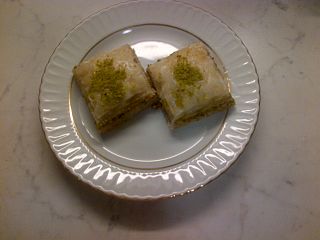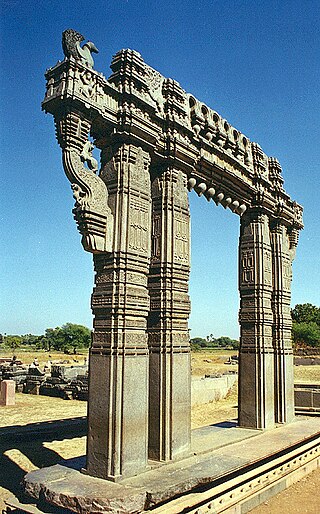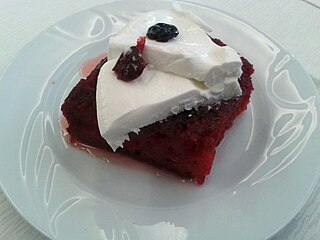This is a list of desserts from Turkish cuisine .
| Name of dessert | Image | Type | Description |
|---|---|---|---|
| Acıbadem kurabiyesi |  | Biscuit | Almond biscuits made from bitter almonds or bitter almond syrup. Well established in Edirne. |
| Alaçatı Kurabiyesi |  | Cookie | Non-dairy Cookie that is flavored with mastic flavor. Alaçatı is a neighborhood of İzmir, the area where this cookie originated from. |
| Ayva tatlısı |  | Fruit | A fruit-based dessert made with quince Originating in the city of Bursa. |
| Badem ezmesi |  | Nuts | Marzipan |
| Baklava |  | Phyllo pastry | A type of phyllo pastry filled with finely chopped nuts and soaked in sharbat syrup. |
| Bağaça |  | Tahini Cake | Bağaça is a kind of tahini cake originated from Antalya. Ingredient in use are flour, butter, sugar, tahini, sesame seeds, pine, rosin, chickpea yeast, and cinnamon. |
| Bici Bici |  | Non-dairy ice | A shaved ice dessert, sweetened with powdered sugar and a red fruit or flower syrup. Additional toppings are added, usually fruits. Originating in the city of Adana. Although the taste is different, due to the use of different toppings and syrup, it is very similar to Korea's Bingsu |
| Biga peynir tatlısı | Pastry | Made of unsalted cheese, dough of flour, egg, water and baking powder | |
| İzmir bombası (Bomb of İzmir or İzmir Bomb) |  | Praline stuffed cookies/kurabiye | Cookies filled with chocolate spread that leave a bomb of chocolatey explosions in your mouth. Originated in the Aegean city of İzmir. |
| Cezerye |  | Candy | Turkish gelatinous sweet made from caramelised carrots, shredded coconut and roasted nuts |
| Cevizli sucuk |  | Candy | Walnuts lined on a strand coated in thickened grape or mulberry juice and dried to resemble sausages |
| Demir tatlısı |  | Fried batter | Fried cookie made with an iron mold |
| Dilber dudağı |  | Pastry | Buttery pastry soaked in sharbat syrup. |
| Dondurma or Maraş Dondurması |  | Battered dairy ice cream | Traditional Turkish ice cream famous for its sellers joking around with customers. The most traditional taste is called Damla sakızı, or, in a literal translation ‘Gummy Drops’. In the Greek society it's known as the ‘Tears of Chios’. Both refer to the mastic taste obtained from the mastic tree. This ice cream originated in the city of Kahramanmaraş, hence the name ‘Maraş ice cream’. |
| Ekmek kadayıfı |  | Bread pudding | The bread or sponge cake dough is mixed with pistachios and hazelnuts before being baked. Then, it will be drenched in a sweet sharbat syrup and served with fresh clotted cream. Originating in the city of Afyonkarahisar |
| Fıstıklı dürüm | Baklava | A kind of rolled, green baklava made with very thin layers of philo dough and thick layers of pistachio | |
| Gaziler helvası | Halva | A type of almond helva from Edirne which has benn traditionally served on special occasions | |
| Güllaç |  | Dairy, fruit | Turkish milk and pomegranate pastry. It is said that it was first made in the Ottoman palace's kitchen by Chef cook Ali from Kastamonu in 1489 |
| Hanım göbeği |  | Pastry | Deep fried choux pastry balls soaked in simple syrup |
| Hayrabolu tatlısı | Pastry | Fried pastry originating from Hayrabolu made from cheese and semolina, decorated with tahin and hazelnuts. It resembles the Kemalpaşa tatlısı and Biga peynir tatlısı | |
| Helatiye |  | Pudding | |
| Hoşaf |  | Fruit | Stewed dried fruits optionally spiced with cloves or cinnamon, may be served cold over rice |
| Hoşmerim |  | Halva | Also called cheese halvah, homemade hoşmerim is made from cheese, semolina and powdered sugar and often served with ice cream, honey or nuts. It has originated in the region of Marmara, with Balıkesir being the most known for it. |
| İncir Uyuşturması or İncir Uyutması, or, 'bring the figs to sleep' | Dairy | Dairy dessert made from dried figs, cow milk, goat milk and sugar. From the city of İzmir. | |
| İrmik Helvası |  | Halva | |
| Kabak tatlısı |  | Fruit | Candied pumpkin garnished with walnuts and fresh kaymak cream (sometimes) (also sometimes topped with tahin). |
| Kadayıf |  | ||
| Kalburabastı |  | Pastry | Syrup-drenched pastries often served during the Islamic holidays |
| Kaysefe | Fruit | Stewed dried fruits topped with melted butter and chopped nuts | |
| Kazandibi |  | Pudding | Caramelized milk pudding |
| Kemalpaşa tatlısı |  | Pastry | |
| Keşkül |  | Pudding | Almond based milk pudding |
| Komposto |  | Fruit | Fresh fruit compote |
| Künefe |  | Tel kadayif dough filled with a layer of cheese and soaked in sharbat syrup. | |
| Lokma |  | Fried batter | Leavened, deep fried dough soaked in sharbat syrup and topped with coconut powder, cinnamon powder, pistachio or hazelnut powder, chocolate sauce, fruits or other toppings. Traditionally, this dessert doesn't use toppings. Very common in Aegean cities such as İzmir or Ayvalık. |
| Lokum |  | Candy | In the English speaking world it is known as “Turkish Delight”. It is eaten together with Turkish Mokka coffee to compensate the strong taste. |
| Lor Tatlısı |  | Pastry | This sweet pastry is made from whey cheese and usually served with mastic flavored traditional Turkish ice cream. It is a local specialty dessert from the coastal town Ayvalık in the Aegean region of Turkey. |
| Macun |  | Fluid Candy | Turkish toffee candy, that is not hard but soft and is stretched over a stick and eaten like a Lollipop. |
| Muhallebi |  | Pudding, dairy | Milk pudding |
| Orcik candy | Candy | Candy coated walnut and fermented grape juice mixture | |
| Pekmez |  | Syrup | Traditionally prepared molasses syrup, usually made from grapes. A great substitute for honey |
| Pepeçura |  | Mousse | Basically a „Mousse au fruit“ made with grape must and thickened with flour and optionally nuts |
| Pestil |  | Fruit | Fruit leather |
| Pişmaniye |  | Helva | Flour roasted in butter blended into pulled sugar. Also called çekme helva, or pulled helva. It often reminds people of cotton candy, but it is very different in taste and texture. It is very similar (in taste and texture and in the making) of the Korean Kkul-tarae and China's Dragon's Beard Candy |
| Revani |  | Cake | Semolina cake soaked in sharbat syrup |
| Şekerpare |  | Pastry | Soft almond pastry soaked in lemon-flavored sharbat syrup |
| Şıllık |  | Crepe | Turkish dessert crepe filled with walnut and topped with sweet syrup and chopped pistachio |
| Şöbiyet |  | Phyllo pastry | Similar to baklava but filled with sweet cream and nuts |
| Supangle |  | Cake, pudding | Chocolate pudding topped cake garnished with chopped pistachio or shredded coconut |
| Sütlaç |  | Pudding, dairy | It is a dessert made using rice, milk and sugar. |
| Sütlü Nuriye |  | Phyllo pastry, dairy | Baklava variation with dairy milk |
| Tavuk göğsü |  | Pudding, dairy | Turkish milk pudding made with fine strands of chicken breast |
| Tulumba |  | Fried batter | Deep-fried batter dough soaked in sharbat syrup |
| Zerde |  | Pudding | Sweet rice pudding colored yellow with saffron |














